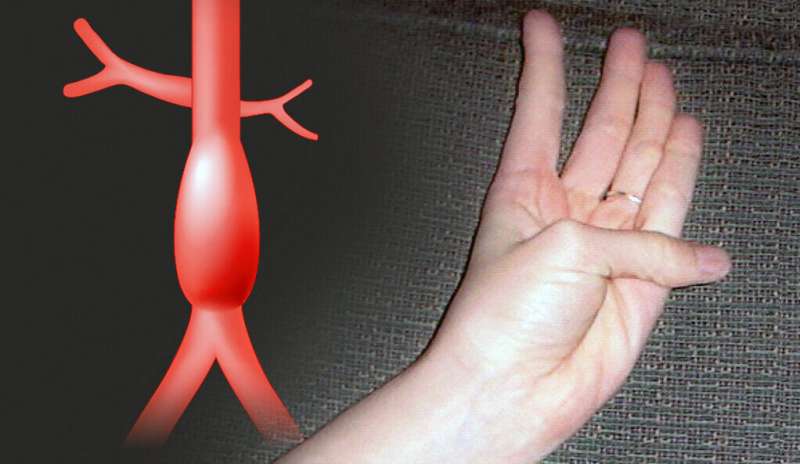All in favor of a test for aortic aneurysms, raise your hand
A Yale study has found that a self-conducted test involving the thumb and palm of one hand could help alert thousands of people each year to their risk of having a hidden aortic aneurysm.
Aortic aneurysms are the 13th most common cause of death among Americans, killing about 10,000 people each year. They affect adults of all ages.
If an aneurysm is detected early enough, a patient can be kept safe via restricting exercise, radiographic monitoring, or surgery.
But aortic aneurysms are hard to detect in advance, physicians say.
"The biggest problem in aneurysm disease is recognizing affected individuals within the general population before the aneurysm ruptures," said Dr. John A. Elefteriades, the William W.L. Glenn Professor of Surgery at Yale and emeritus director of the Aortic Institute at Yale New Haven Hospital. He is senior author of the new study, published in the American Journal of Cardiology.
For at least the past two decades, Elefteriades said, he and his colleagues have included the thumb-palm test in lectures to medical students and used the test for patients who might be at risk of carrying an aneurysm.
Yet despite its frequent usage, the test's accuracy had not been evaluated in a clinical setting, the researchers said.
The test is simple: Holding up one hand and keeping the palm flat, the patient flexes their thumb as far as possible across the palm. If the thumb crosses beyond the far edge of the flat palm, the patient may be harboring a hidden aneurysm.
Being able to move the thumb in that way is an indication that a patient's long bones are excessive and their joints are lax—possible signs of connective tissue disease throughout the body, including the aorta.
The researchers said it is important to emphasize that not everyone who tests positive is an aneurysm carrier. Also, they noted, aneurysms often take decades to progress to the point of rupture and a positive test is not cause for panic.
For the study, the researchers gave the test to 305 patients undergoing cardiac surgery for a variety of disorders, including aortic aneurysms. "Our study showed that the majority of aneurysm patients do not manifest a positive thumb-palm sign, but patients who do have a positive test have a high likelihood of harboring an aneurysm," Elefteriades said.
Based on their findings, Elefteriades and his colleagues said the thumb-palm test should be included in standard physical examinations of patients—particularly those who have a family history of aortic aneurysm.
"Spreading knowledge of this test may well identify silent aneurysm carriers and save lives," Elefteriades said.
- Karlston
-

 1
1




Recommended Comments
There are no comments to display.
Join the conversation
You can post now and register later. If you have an account, sign in now to post with your account.
Note: Your post will require moderator approval before it will be visible.